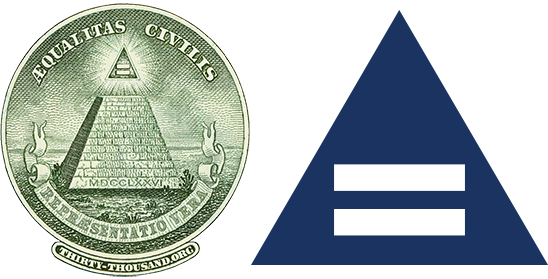Restoring representative government will require thousands of Representatives
Adding a few hundred Representatives would not solve any problems. There is only one way to overcome the cumulative damage of nearly two centuries of representational deprivation: Add thousands of Representatives—just as the founders intended.
In 1913, when our nation’s population totaled 91 million, the U.S. House of Representatives had 435 members, which was less than a fourth of what the founders would have expected.1Pursuant to the intended version of Article the first, there should have been at least 1,820 Representatives for this population level. Since then, our total population has more than tripled to 331 million, and yet we still have only 435 Representatives! Consequently, the average congressional district population has swelled from 220 thousand in 1913 to over 760 thousand today, as illustrated in the chart below.
As explained by Thirty-Thouand.org, our House of Representatives has been undersized for nearly two centuries, resulting in a host of pernicious inequities which have been cumulatively corrosive to our republic.
And because it is becoming increasingly difficult to ignore how grossly inadequate our representation is, there have been calls for enlarging it. For example, the New York Times’ Editorial Board has twice advocated for a larger House, observing that “the House today is far too small, and that poses a big danger to American democracy”.
As the saying goes, admitting that you have a problem is the first step towards fixing it. And a House of Representatives that is “far too small” is a serious problem which can no longer be denied.
The undeniable problem
The best way to understand the problems resulting from underrepresentation is by first considering them from the most favorable perspective possible: Imagine a world in which there are no political parties, and all 435 Representatives are very honorable and well-intentioned people, so much so that they eschew any fundraising in order to focus all their efforts on diligently serving their constituents. Even then, it would be absolutely impossible for those 435 men and women to faithfully represent the diversity of 330 million Americans. Likewise, it would be impossible for any one of them to represent the diversity embodied in congressional districts that encompass 543 thousand to nearly a million people, no matter how impartially those districts were drawn.
In addition, even in such a world, the House of Representatives would be in egregious violation of the Constitution’s one-person-one-vote equality requirement. And likewise, representation in the Electoral College would be inequitably misallocated to the states. Regardless of how virtuous those Representatives may be, all of these inequities are mathematically inevitable consequences of having a House that is far too small for a huge multi-state republic.
However, we don’t live in that ideal world. In our world, those problems are exacerbated by the reality of having career politicians who are often focused on accumulating power and wealth. In order to keep their jobs, the Representatives must continuously beg for money to fund their hugely expensive election campaigns in massive congressional districts, thereby making most of them more beholden to the various Special Interests than to their own constituents.
In our world, we also have two powerful political parties engaged in a relentless battle for the domination of our government. With relatively few seats in play, the stakes are so high that almost every ruthless tactic is employed, including maximized gerrymandering, miscounting the population censuses, and widespread election fraud.
Worse yet, this battle is not confined to the actions of these two formidable antagonists; for at least one party, it also extends to their proxies in corporate media and powerful government agencies, thereby expanding this toxic sphere of partisanship in such a way as to corrupt institutions that should be impartial. However, to be fair, it cannot be said that the Democrat and Republican parties never cooperate. They do collaborate to impede the rise of any third-party or independent candidates who might threaten their political duopoly. And occasionally, thanks to Special Interest pressure, bipartisan agreement is reached on assisting certain industries or authorizing costly foreign interventions.
Like all the other aforementioned threats to our republic, the very existence of this duopolistic hegemony is a result of there being far too few Representatives—contrary to the founders’ expectations.
The search for a solution
Though there is an emerging consensus that the people’s representation in Congress needs to be greatly enlarged, the challenge is finding the solution that would best restore and preserve our representative government. That is a difficult question; as Madison observed: “No political problem is less susceptible of a precise solution than that which relates to the number most convenient for a representative legislature.”2Federalist 55.And it doesn’t help that this problem is both political and mathematical in nature, two subjects which fail to inspire widespread enthusiasm. Nonetheless, it is such a fundamental issue, that the very first amendment proposed for our Bill of Rights was intended to resolve it once and for all!
In an effort to put forth a solution, the New York Times editorials (referenced above) recommended that Congress pass legislation requiring that the total number of Representatives be equal to the cube-root of the total population. A commonly cited proposal, the cube-root “law” is also recommended in separate reports issued by the Fordham University Law School’s Democracy and the Constitution Clinic3Why the House of Representatives Must Be Expanded and How Today’s Congress Can Make It Happen and by FairVote.org.4More Members, More Voices Based on the 2020 population census, the cube-root formula would suggest a total House size of 692 Representatives, an increase of 257 over the current House size. However, none of those reports substantiate that such an increase would mitigate the various problems they identified as resulting from our undersized House.
A recent report issued by the American Academy of Arts & Sciences 5The Case for Enlarging the House of Representatives also recommends enlarging the House. It reviews several different possible algorithms for determining a larger size, including the cube-root formula. They dismiss those algorithms in favor of simply adding 150 Representatives, essentially replacing one arbitrary number (435) with another (585). Their proposal is based on a contrived rationale of retroactively applying a principle of non-decrementation to the apportionment process.6For every decennial apportionment beginning with (and including) the 1930 apportionment, augment the total number of Representatives as if each apportionment had been increased just enough so that no state would have lost any Representatives through reapportionment. And then, if the resulting total is an even number, increment it to the succeeding odd number (to reduce the likelihood of a split vote in the House). However, the American Academy’s report does not show how an increase to 585 would ameliorate the various problems identified in their report.
All of these organizations should be praised for boldly calling for increasing the number of Representatives in order to overcome the insidious problems resulting from an undersized House. Unfortunately, a deeper analysis reveals that enlarging our House by only a few hundred Representatives would not do anything to mitigate the corrosive consequences of decades of underrepresentation.
Historical context
It may surprise many that no noticeable benefits would result from increasing the number of Representatives from 435 to 692 (as suggested by the cube-root model). After all, that’s a 59% increase, which certainly seems large! However, such an increase must be put into historical context: In 1788, Federalist 55 assured Americans that “it can scarcely be doubted that” there will be 400 Representatives by 1838. And one of the drafters of the Constitution predicted that there would be more than 600 Representatives by 1887.7James Wilson predicted in 1787 that “the House of Representatives will, within a single century, consist of more than six hundred members.”. Think about that: Decades before the invention of wondrous technological marvels such as the steam railway locomotive and electric telegraphy, the founders were envisioning “more than six hundred” Representatives traveling from distant places to converge upon the federal capital. And yet, 135 years past that date, we are not even allowed three-quarters as many!
This insidious degradation of our republican form of government has been so gradual, transpiring over so many generations, that Americans generally do not realize it is the root cause of virtually every major problem plaguing our country. Consequently, modern Americans are not aware of how grossly undersized our House of Representatives is relative to what was intended by the founders. And imagine how much worse this situation will become as the U.S. population continues to grow: The average congressional district population will be approximately 870 thousand by 2040 (at 435 Representatives). And as congressional districts become even more massive in the future, the Representatives will become even more servile to the powerful Special Interests (both domestic and foreign) that fund their spectacularly expensive political campaigns. Will Americans simply continue to surrender their political sovereignty to these powerful moneyed interests?
A solution in form, not in substance
The cumulative damage done to our republic by decades of representational deprivation cannot be remedied by a trivial increase in the number of Representatives (e.g., to 692). However, in order to create the appearance of attempting to solve these problems, the political class may eventually allow such an increase.
And if Congress deigned to grant us a few hundred additional Representatives, they could then declare: We have enlarged your representation, and nothing improved, so there is no point in seeking additional enlargement. They and their media mouthpieces would then instruct us to continue blaming the opposing political party for the continued problems, because as long as we are fighting amongst ourselves, the political ruling class can continue unimpeded.
Therefore, not only would such an increase fail to mitigate the problems resulting from an undersized House, it would actually provide an ostensible rationale for the continued reign of America’s political ruling class: Whereas 435 is obviously an indefensibly arbitrary number, the “Cube-Root Law” could pose as a “scientific” solution, and thereby preempt the increase necessary to return control of the “People’s House” back to the people.
Government of, by, and for… the People or the Special Interests?
To determine the correct size of the House, there is a formulation based on the Constitution’s equality requirement and mandated by the Fourteenth Amendment. Moreover, the very first amendment in our Bill of Rights was intended to codify this principal, which we call the Founders’ Rule. Based on the 2020 census, a House size of 6,692 would conform with the Founders’ Rule. At that size, one-person-one-vote equality is achieved and so is interstate parity in the Electoral College. And, as explained throughout this web pamphlet, it would also overcome all the other pernicious political inequities we suffer under today, including Special Interest domination and gerrymandering.
Defenders of the Status Quo will counter that such a large House is “unwieldy”. Yes, it would be quite unwieldy for the Special Interests. They prefer having a small number of amenable politicians conveniently concentrated in D.C., rather than there being thousands of independent citizen legislators working from their home districts (under the watchful eyes of their constituents). The fact is, the House of Representatives is highly scalable, as virtually all of its work is done in its subcommittees. What is truly unwieldy today is having one Representative endeavoring to represent hundreds of thousands!
With respect to greatly enlarging the House, the Defenders of the Status Quo will also proclaim a newfound apprehension of increasing government expenditures (but only with respect to granting additional representation to the people). The fact is, the cost of significantly enlarging the House of Representatives would be, at worst, a break-even proposition.
The truth of the matter is, if we are unwilling compel our Congress to authorize thousands of additional Representatives, then we should resign ourselves to living with the pernicious consequences of a grossly undersized House and abandon the pretense of trying to solve all those perennial problems. We should openly declare that maintaining America’s ruling class is more important than establishing one-person-one-vote equality, neutralizing the Special Interests, eliminating gerrymandering, and having a House that truly represents the diversity of the American people.
In other words, if we are not willing to compel our Congress to grant the thousands of Representatives necessary to restore the People’s House to the people, then we should candidly proclaim: Let there be government of the Special Interests, by the Special Interests, and for the Special Interests.
© Thirty-Thousand.org [published 10/04/22]
- 1Pursuant to the intended version of Article the first, there should have been at least 1,820 Representatives for this population level.
- 2Federalist 55.
- 3
- 4
- 5
- 6For every decennial apportionment beginning with (and including) the 1930 apportionment, augment the total number of Representatives as if each apportionment had been increased just enough so that no state would have lost any Representatives through reapportionment. And then, if the resulting total is an even number, increment it to the succeeding odd number (to reduce the likelihood of a split vote in the House).
- 7James Wilson predicted in 1787 that “the House of Representatives will, within a single century, consist of more than six hundred members.”.





